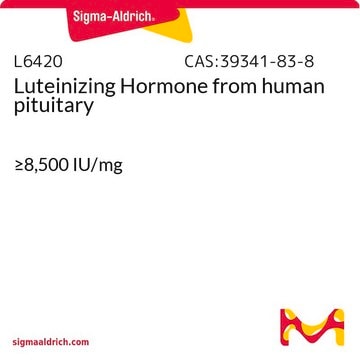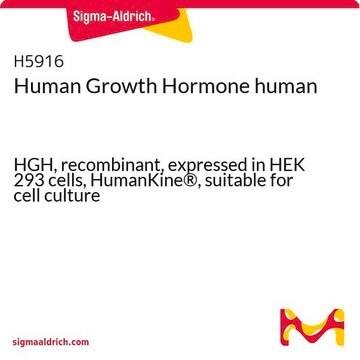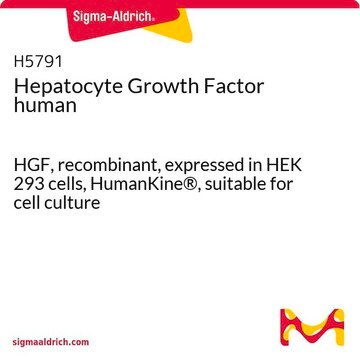SRP4689
Prolactin from rat
recombinant, expressed in E. coli, ≥95% (SDS-PAGE), ≥95% (HPLC)
Synonym(s):
Luterotropic hormone, Lutetropin, Mammotropin, PRL
Sign Into View Organizational & Contract Pricing
All Photos(1)
About This Item
UNSPSC Code:
12352200
NACRES:
NA.32
Recommended Products
biological source
rat
recombinant
expressed in E. coli
assay
≥95% (HPLC)
≥95% (SDS-PAGE)
form
lyophilized
mol wt
~22.5 kDa
packaging
pkg of 50 μg
storage condition
avoid repeated freeze/thaw cycles
impurities
endotoxin, tested
NCBI accession no.
shipped in
wet ice
storage temp.
−20°C
Gene Information
rat ... Prl(24683)
General description
Prl (prolactin) is an anterior pituitary hormone, with a molecular weight of 23kDa. It is processed into several molecular forms such as phosphorylated, glycosylated, and lower molecular weight forms. Cleavage of the native protein results in the production of multiple N-terminal fragments of 14 to 18kDa molecular weights, known as vasoinhibins.
Recombinant mouse Prolactin is a 22.5 kDa globular protein containing 198 amino acid residues.
Recombinant mouse Prolactin is a 22.5 kDa globular protein containing 198 amino acid residues.
Biochem/physiol Actions
Prl (prolactin) is processed to lower molecular weight N-terminal fragments, 14-18kDa, called vasoinhibins which have antiangiogenic effects. In endothelial cells, the 16kDa prolactin form exerts antiproliferative and proapoptotic effects which result in cell cycle arrest, caspase and NFκB (nuclear factor) activation, and regulation of Bcl-2 (B-cell lymphoma 2) protein family. In sexually mature female mice, the plasma levels of prolactin remain constant throughout estrous cycle, but show a sudden increase during proestrous cycle due to increase in circulating levels of estrogens. Studies show that Prl activates T cells, B cells, natural killer (NK) cells, macrophages, neutrophils, and dendritic cells, and there is a significant level of hyperprolactinemia incidence in patients with autoimmune diseases, such as rheumatoid arthritis (RA) and systemic lupus erythematosus (SLE). Studies in rats show that Prl is involved in T cell homing to mammary glands during early lactation, and that hypoprolactemia during lactation results in modified T cell distribution with increased T cell in circulation and reduced in mammary glands.
Physical form
Sterile filtered and lyophilized from 10 mM Sodium Phosphate, pH 8.0 plus 50 mM NaCl.
Reconstitution
Centrifuge the vial prior to opening. Avoid freeze-thaw cycles.
Reconstitute in water to a concentration of 1.0 mg/mL. This solution can then be diluted into other aqueous buffers.
Storage Class
11 - Combustible Solids
wgk_germany
WGK 3
flash_point_f
Not applicable
flash_point_c
Not applicable
Certificates of Analysis (COA)
Search for Certificates of Analysis (COA) by entering the products Lot/Batch Number. Lot and Batch Numbers can be found on a product’s label following the words ‘Lot’ or ‘Batch’.
Already Own This Product?
Find documentation for the products that you have recently purchased in the Document Library.
Impaired mammary gland T cell population during early lactation in hypoprolactinemic lactation-deficient rats.
Mackern-Oberti JP et al
Reproduction (Cambridge, England), 146(3), 233-242 (2013)
N-terminal prolactin-derived fragments, vasoinhibins, are proapoptoptic and antiproliferative in the anterior pituitary.
Ferraris J et al
PLoS ONE, 6(7), e21806-e21806 (2011)
Our team of scientists has experience in all areas of research including Life Science, Material Science, Chemical Synthesis, Chromatography, Analytical and many others.
Contact Technical Service






